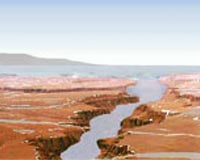 |
for Astrobiology Magazine Moffett Field CA (SPX) Jun 05, 2009 Extremophile bacteria can tough it out in the Siberian permafrost, but the environment of Mars may still be too hostile for such hardy life. That's the finding of a recent study conducted by Andrew C. Schuerger, a microbiologist at the University of Florida and the Space Life Sciences Lab at NASA's Kennedy Space Center in Florida, and colleagues. "Very seldom have microbes that grow well under cold or high salt conditions been subjected to Martian conditions," said Schuerger. Harsh ultraviolet (UV) light proved particularly devastating for the survival of cold-resistant microbes under simulated surface conditions on Mars. Such findings not only hone the search for traces of Martian life, but also could help focus NASA's procedures to prevent contamination of Mars by Earth microbes.
Cold Case for a Small Suspect Schuerger and his colleagues chose to test Psychrobacter cryohalolentis, an extremophile that thrives under extremely dry conditions and at temperatures as low as minus 10 degrees C. That choice allowed them to push scientific understanding of what may or may not survive on the Martian surface. "If we can find any of extremophilic terrestrial species that are capable of growth and replication under Martian conditions, it puts the search for life on Mars a bit closer to success," Schuerger explained. Testing under Martian surface conditions meant turning to the Mars Simulation Chamber (MSC) at the Kennedy Space Center, where researchers simulated everything from dust free skies to global dust storm conditions. The study grew out of the undergraduate work of David Smith from Princeton University, who has since gone on to conduct his Ph.D. research at the University of Washington. The team also tested how well a salt mineral matrix similar to parts of the Martian surface could protect against UV, and how well the extremophiles dealt with very dry conditions.
No Escape from UV "We found that the UV radiation was readily and easily able to penetrate the salt-organic matrix that the bacterial cells were embedded in," Schuerger said. Such findings suggest that this type of extremophile poses little risk of spreading across the surface of Mars - at least not on its current-day hostile surface environment. P. cryohalolentis even fared poorly under the dry conditions on the lab bench, let alone inside the Mars simulator. The study points to a need for future investigations on how much UV protection a microbe can find in salt mineral layers within the Martian regolith. "The research emphasizes the point that you're not going to automatically get protection from UV when embedded within salt deposits," Schuerger noted. "Some salt encrustations might protect with just a few millimeters of salt, while others might need 5 to10 centimeters." UV is not the only challenge facing hitchhiking microbes. Schuerger's past research found at least 13 separate factors on Mars that can kill Earth microbes, not counting perchlorate salts uncovered by NASA's Phoenix Mars Lander in the polar region of Mars.
Digging Deeper Into the Future "I'm not overly worried that we're contaminating landing sights," Schuerger said. "I'm not suggesting that we relax planetary protection protocols, either, but current ones appear to be very good." That's not to say that NASA missions don't pose any contamination risk, given the dust that may get kicked up and cover surviving microbes with a protective layer, he added. Future missions that have landers or rovers digging deeper beyond the top 10 or 20 centimeters of the Martian surface may require additional risk studies. "Whether or not microbes will survive when we drill down to depth, that's a wide open question at this point," Schuerger cautioned. Studies like Schuerger's, and more complex robotic or human missions to Mars over the next several decades, may provide some answers. Share This Article With Planet Earth
Related Links Space Life Sciences Lab Mars News and Information at MarsDaily.com Lunar Dreams and more
 Early Martian Environment And Water Drive Search For Life Forms
Early Martian Environment And Water Drive Search For Life FormsNew Rochelle (SPX) Apr 17, 2009 Solar energy and winds, collisions with asteroids and comets, and changing magnetic fields have all altered the environment of Mars, a planet that may have been able to support life during its history, as documented in a special collection of papers published in the current issue of Astrobiology, a peer-reviewed journal published by Mary Ann Liebert, Inc. Compiled by Helmut Lammer, PhD, Se ... read more |
|
| The content herein, unless otherwise known to be public domain, are Copyright 1995-2009 - SpaceDaily. AFP and UPI Wire Stories are copyright Agence France-Presse and United Press International. ESA Portal Reports are copyright European Space Agency. All NASA sourced material is public domain. Additional copyrights may apply in whole or part to other bona fide parties. Advertising does not imply endorsement,agreement or approval of any opinions, statements or information provided by SpaceDaily on any Web page published or hosted by SpaceDaily. Privacy Statement |